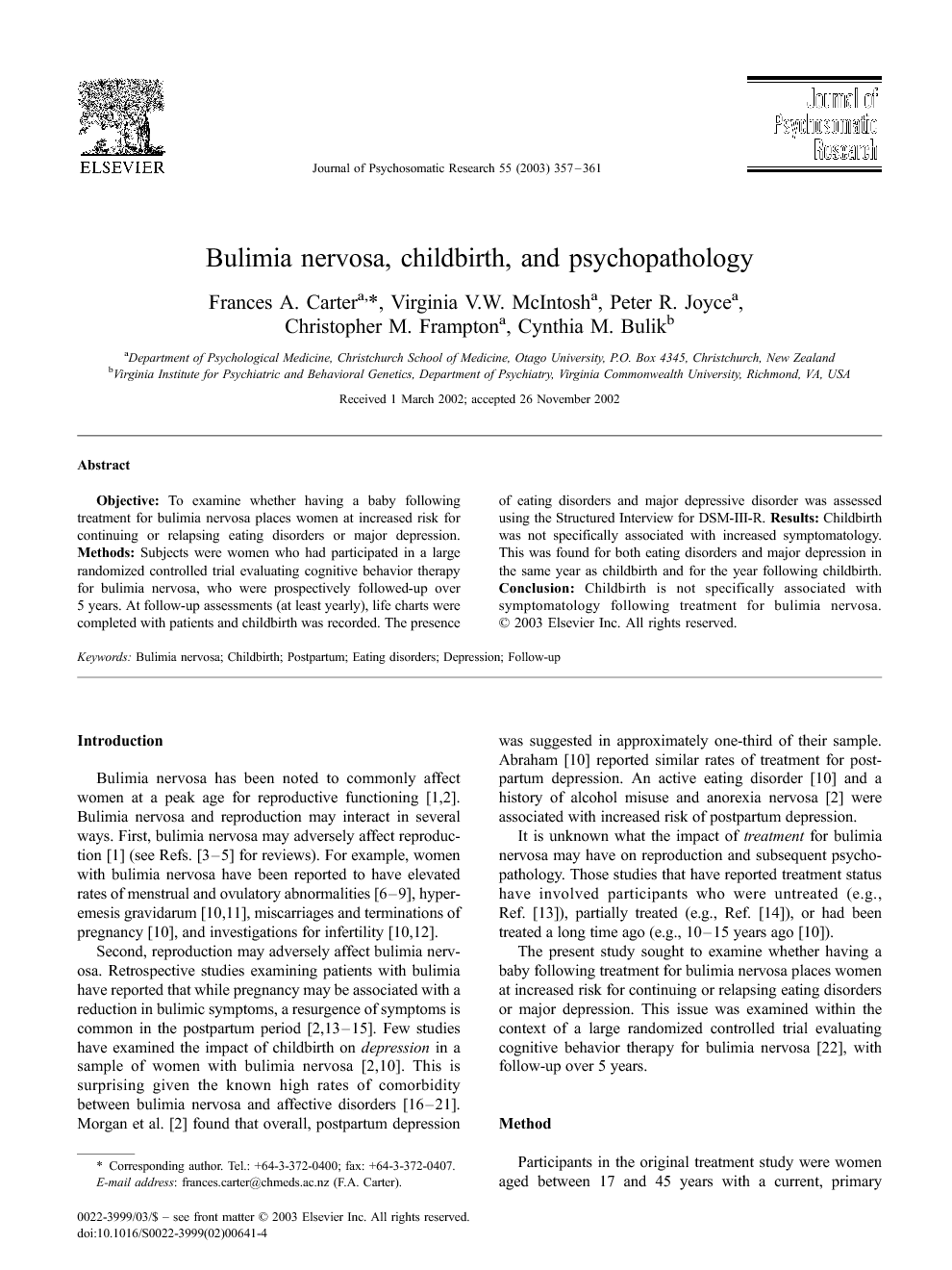Objective: To examine whether having a baby following treatment for bulimia nervosa places women at increased risk for continuing or relapsing eating disorders or major depression. Methods: Subjects were women who had participated in a large randomized controlled trial evaluating cognitive behavior therapy for bulimia nervosa, who were prospectively followed-up over 5 years. At follow-up assessments (at least yearly), life charts were completed with patients and childbirth was recorded. The presence of eating disorders and major depressive disorder was assessed using the Structured Interview for DSM-III-R. Results: Childbirth was not specifically associated with increased symptomatology. This was found for both eating disorders and major depression in the same year as childbirth and for the year following childbirth. Conclusion: Childbirth is not specifically associated with symptomatology following treatment for bulimia nervosa.
Bulimia nervosa has been noted to commonly affect women at a peak age for reproductive functioning [1] and [2]. Bulimia nervosa and reproduction may interact in several ways. First, bulimia nervosa may adversely affect reproduction [1] (see [3], [4] and [5] for reviews). For example, women with bulimia nervosa have been reported to have elevated rates of menstrual and ovulatory abnormalities [6], [7], [8] and [9], hyperemesis gravidarum [10] and [11], miscarriages and terminations of pregnancy [10], and investigations for infertility [10] and [12].
Second, reproduction may adversely affect bulimia nervosa. Retrospective studies examining patients with bulimia have reported that while pregnancy may be associated with a reduction in bulimic symptoms, a resurgence of symptoms is common in the postpartum period [2], [13], [14] and [15]. Few studies have examined the impact of childbirth on depression in a sample of women with bulimia nervosa [2] and [10]. This is surprising given the known high rates of comorbidity between bulimia nervosa and affective disorders [16], [17], [18], [19], [20] and [21]. Morgan et al. [2] found that overall, postpartum depression was suggested in approximately one-third of their sample. Abraham [10] reported similar rates of treatment for postpartum depression. An active eating disorder [10] and a history of alcohol misuse and anorexia nervosa [2] were associated with increased risk of postpartum depression.
It is unknown what the impact of treatment for bulimia nervosa may have on reproduction and subsequent psychopathology. Those studies that have reported treatment status have involved participants who were untreated (e.g., Ref. [13]), partially treated (e.g., Ref. [14]), or had been treated a long time ago (e.g., 10–15 years ago [10]).
The present study sought to examine whether having a baby following treatment for bulimia nervosa places women at increased risk for continuing or relapsing eating disorders or major depression. This issue was examined within the context of a large randomized controlled trial evaluating cognitive behavior therapy for bulimia nervosa [22], with follow-up over 5 years.
Method
Participants in the original treatment study were women aged between 17 and 45 years with a current, primary diagnosis of bulimia nervosa [23]. Exclusion criteria were current anorexia nervosa, current obesity (body mass index [BMI] >30 kg/m2), current severe major depression with severe suicidal ideation or requiring immediate treatment with antidepressants, current severe medical illness or severe medical complications of bulimia nervosa, or the current use of psychoactive medication and unwillingness to undergo a supervised drug wash-out period. The original sample have been described in detail elsewhere [22].
Patients were assessed at pretreatment, mid-treatment, end-treatment, 6 months posttreatment, and at yearly intervals posttreatment for 5 years. Fig. 1 shows an overview of the study design. Over the follow-up period, the presence of the following Axis I disorders was determined using the Structured Clinical Interview for DSM-III-R [24]: bulimia nervosa, anorexia nervosa, eating disorders not otherwise specified, major depressive syndrome, substance-use disorders, and social phobia. Diagnoses were made for the past month and for the past year. The present study reports data for the past year. These diagnoses indicate that all diagnostic criteria were met at any stage over the past year, including in the past month. A summary variable “eating disorder (any)” was calculated (yes/no). The present study utilizes this summary variable in order to minimize repeated comparisons and avoid problems with small numbers with diagnoses of anorexia nervosa.


